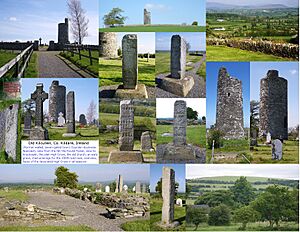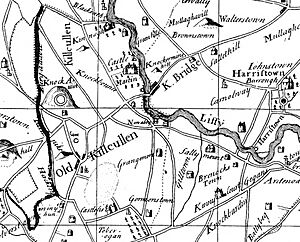Old Kilcullen facts for kids
Quick facts for kids
Old Kilcullen
Sean Chill Chuilinn
|
|
|---|---|
|
Town
|
|
| Country | Ireland |
| Province | Leinster |
| County | County Kildare |
| Time zone | UTC+0 (WET) |
| • Summer (DST) | UTC-1 (IST (WEST)) |
| Irish Grid Reference | N830071 |
Old Kilcullen is a historic place in County Kildare, Ireland. Its name in Irish, Cill Chuilinn, means "the Church of the Holly". It is known for an important old religious site.
Old Kilcullen is a large area of land, but not many people live there. You can find it near the R418 and R448 roads. Long ago, Old Kilcullen was a walled town. Even before that, it was a very old church settlement from the 400s. This early settlement gave its name to the wider area around it.
The main town area moved about 2 kilometers away to Kilcullen Bridge on the River Liffey. This happened after a bridge was built there in 1319. Today, Kilcullen Bridge is often just called Kilcullen. Old Kilcullen is close to Newbridge and Naas.
At Old Kilcullen, you can see a round tower and a beautiful decorated High Cross. Another very old site, Dun Ailinne, is about one kilometer north at Knockaulin.
Finding the Ancient Site
The old religious site of Old Kilcullen is on a hill. It is about 2 kilometers from Kilcullen Bridge. You can get there by taking small roads off the R418 or R448. These roads are easy to reach from the M9 motorway.
Today, the site looks like a churchyard with old stone buildings. But studies from the air and ground show it was once a much bigger settlement. It even had earth walls on the hill's slopes.
There is no public transport directly to the site. However, Kilcullen Bridge has bus services that can get you close.
A Look Back in Time
Old Kilcullen started as a church settlement around the year 448. It is believed that St. Patrick sent clergy there. The location might have been chosen because it was near Dun Ailinne. Dun Ailinne was an important ceremonial place for the kings of Leinster.
The settlement had a bishop, St. Iserninus, and later St. MacTail. It is not clear if they were there at the same time.
Viking Raids and Growth
Vikings attacked Old Kilcullen at least twice, in 936 and 944. During the first raid, about a thousand people were captured. This shows that many people lived there at the time. Old records also mention the deaths of important church leaders, like bishops and abbots.
The town was at its busiest during early Anglo-Norman times. It was a walled town with seven gates and many roads. It also had regular markets. There was a castle, which was later owned by the Eustace family.
The Rise of Kilcullen Bridge
The new town, now called Kilcullen Bridge, began to grow after 1319. A church leader named Maurice Jakis built a bridge across the River Liffey there. Over many centuries, this new center became more important than Old Kilcullen. However, Old Kilcullen still had more people until the late 1800s. The new settlement was first built only on the east side of the river.
Later Events in History
Conflicts and Rebellions
In 1641, a fort here was held by parliamentary forces. It was later taken by the Royalist army. Then, in 1647, the parliamentarians took it back and burned it.
Old Kilcullen was also the site of the Battle of Kilcullen on May 27, 1798. This was part of the 1798 rebellion. The rebels won the first part of the battle. But then General Dundas drove them out and back to Knockaulin. During the battle, the round tower was damaged. It had four windows before, but only one was left. It was later made safe again.
Changes in the 1800s
At some point, Old Kilcullen lost its market to Kilcullen Bridge. It kept a small fair twice a year. It also had a small church until the mid-1800s. The money from this church helped support two canons in Christchurch Cathedral, Dublin.
The main road from Dublin also moved away from the hill. This caused Old Kilcullen to lose more activity. The round tower was taken care of by the State in the late 1800s.
The Gordon Bennett Road Race
In 1903, one of the first international car races, the Gordon Bennett Road Race, happened in Ireland. It started in the Old Kilcullen area. The main viewing stand was at Ballyshannon Crossroads. A German driver won the race.
This race is where the color British Racing Green began. Britain needed a different color for its cars because other countries had taken red, white, and blue. To show respect for their Irish hosts, the British cars were painted shamrock green. This is why early British racing cars were often light olive or emerald green. Later, darker shades became more common.
Old Kilcullen Today
Not much of the original town is visible now. You can see a low-walled churchyard. It has the damaged round tower and parts of an old church. There are also two Irish High Crosses and the base of another large cross. Many graves are also there. However, pictures taken from the air show more hidden structures.
Besides the historic area, the townland of Old Kilcullen has homes, farms, a pub, and a water reservoir. A part of the M9 motorway, opened in 2009, goes through the northeast corner of Old Kilcullen.
The Round Tower
The round tower is now just over 10 meters tall. It was damaged during the Battle of Kilcullen and later made stable. Only one window remains from at least four large ones seen in old drawings. The round-headed doorway is about 1.7 meters high. It is about 2 meters above the ground. A plaque next to the door says the tower is a protected site.
The High Crosses
There are two special Irish High Crosses in the churchyard. There might also be the base of a third one.
The "decorated high cross" has four sides with carved pictures. It was not always in one piece. It was leaning by 1862 and lay on the ground for years. When it was put back up in the late 1800s, some parts were lost. Parts that faced up were also badly worn away.
The "plain high cross" might have been meant to be decorated, but it has no finished carvings.
The Church Remains
The parts of the church that are left are now only slightly above the ground.
Lost Structures
Until the late 1700s, one of the town's famous "seven gates" was still standing.
More Information
- Kilcullen(-Bridge), Co. Kildare, Ireland: The Bridge (monthly publication, 1970s to today), various issues, various committee members / editors
- Grose, Francis: Antiquities of Ireland, Vol. 2 (of 2), preface illustration and pp. 27–28 with second illustration (illustrations by Lieut. Daniel Grose)






